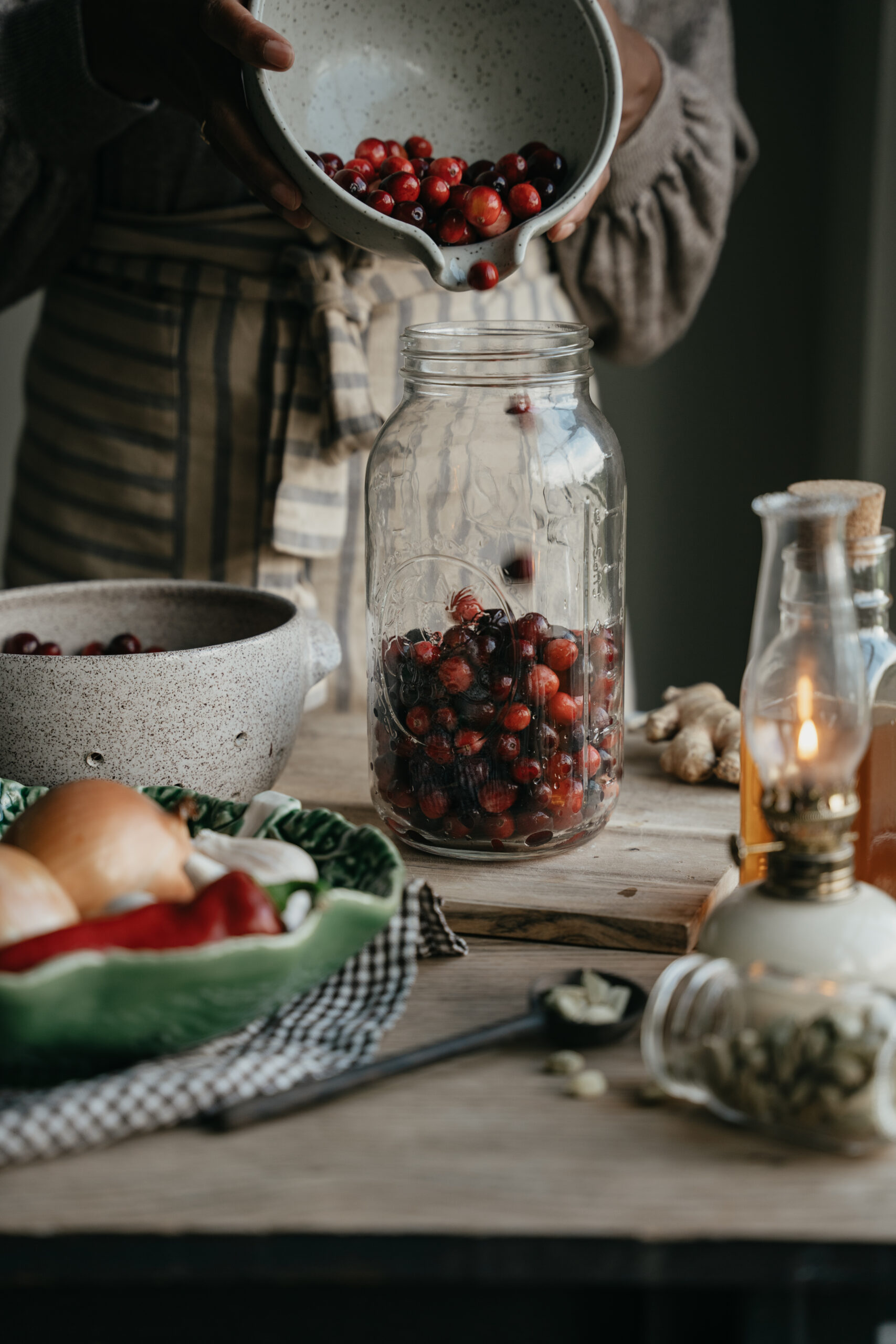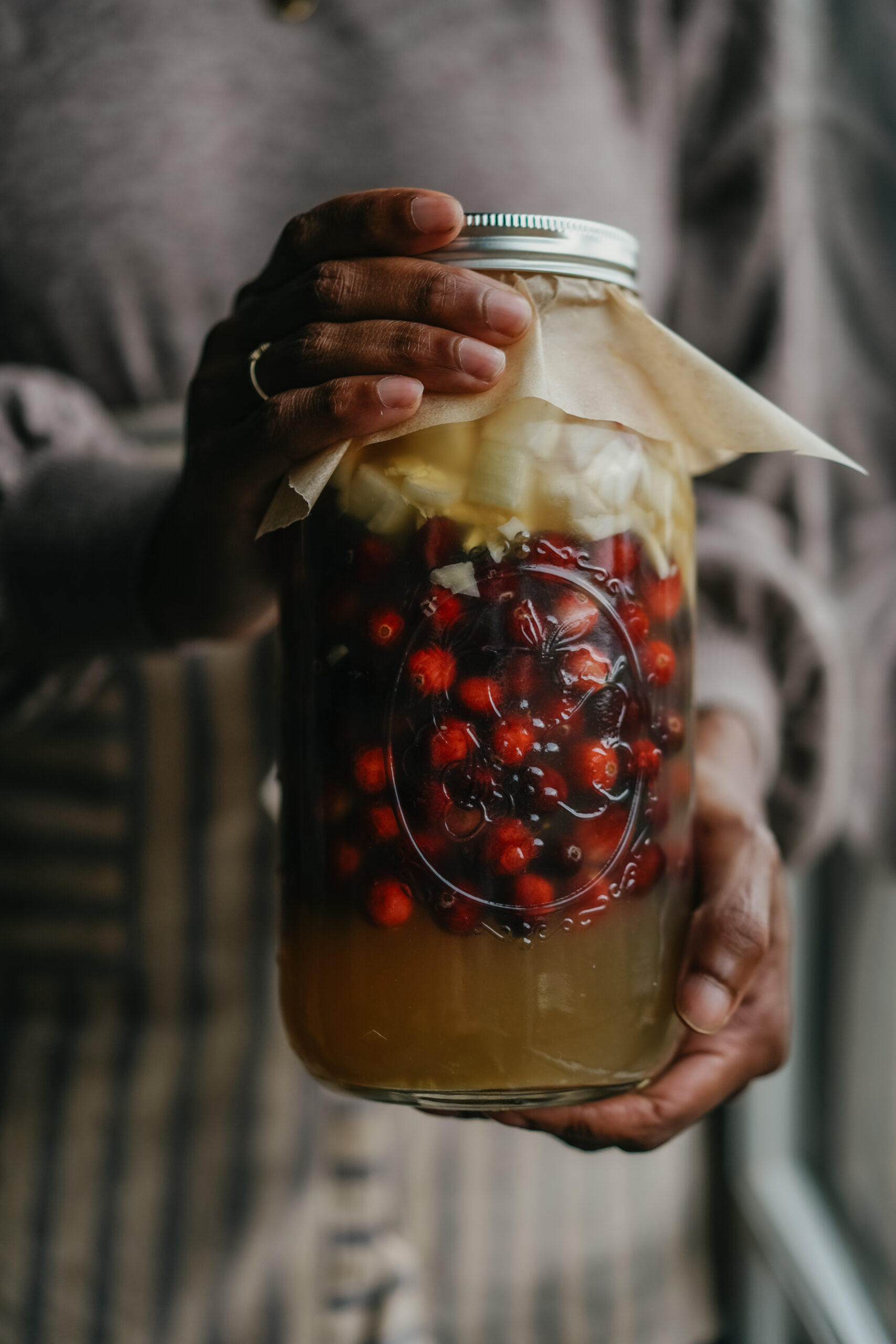
A Must Try Fire Cider Recipe Using Unexpected Herbs
Fire cider, the renowned vinegar-based infusion of pungent plants, is an altogether invigorating concoction with a real spicy history in traditional folk herbalism. In this article, we have a creative spin on the traditional fire cider with a Cranberries and Cardamom Fire Cider recipe we are sharing below!
The story of fire cider recipe’s rise to modern prominence can be traced back to the teaching kitchen of revered herbalist Rosemary Gladstar around the year 1980. At the time, drinking apple cider vinegar and an excessive amount of cayenne pepper was a health trend that emerged from Dr. John Christopher’s school of herbalism.
During a class on winter wellness in the damp and chilly Pacific Northwest, Rosemary chopped up the ingredients we now know as the base of fire cider: garlic, onion, ginger, and horseradish. These plants were tossed into a jar and covered with apple cider vinegar and honey, and fire cider was born (Gladstar, 2019).
To learn more about this beverage’s storied past, and for more exciting fire cider recipes check out Herbal Academy’s Business Herbal Course.
Let’s be clear though, there is a historical record of recipes involving aromatic and pungent plants steeped in vinegar across cultures, including the four thieves recipe, well known as a concoction used by grave robbers in Europe in the Middle Ages. This is not new. It is a time-honored method of extracting beneficial plants and applying them for human use. Indeed, fire cider is one herbal preparation we love to share with our Herbal Academy students!

Benefits of Fire Cider
This array of deeply warming and aggressively flavorful herbs turned out to ignite people in more ways than it was originally intended! There is a lot to be said about the blood-moving capacity of this blend of plants. The phytochemicals in these herbs are what give them their flavor profiles but also provide their circulatory stimulating effects.
Garlic (Allium sativa) has a long history of use in herbalism for its beneficial effects on the cardiovascular system. Modern research shows garlic can thin the blood, dilate blood vessels, and modulate inflammation throughout the circulatory system, resulting in an overall reduction in blood pressure in cases of hypertension (Wang et al., 2015).
Species of hot peppers from the genus Capsicum contain the phytochemical capsaicin, which give these fruits the heat they are known for. The hotter the pepper, the higher its level of capsaicin. Capsaicin is not only strong in taste, but also in action. The cardioprotective activity of capsaicin includes multiple pathways in which capsaicin-containing peppers reduce inflammation in blood vessels (Lu et al., 2020).
Additionally, within the digestive system, hot peppers get things moving. They stimulate gastric enzyme and bile secretion release, increasing the breakdown of fats and improving nutrient absorption (Lu et al., 2020).

When extracted in an apple cider vinegar base, the power of peppers and fire cider recipe’s other foundational ingredients make for a digestive dream team.
The fermentation process used to produce apple cider vinegar nets us a golden liquid rich in acetic acid. One of the bodily bounties reaped from this sour beverage is the slowing down of the rate of gastric emptying. This reduces the speed at which glucose is absorbed into our bloodstream, in turn plateauing blood sugar spikes, which is beneficial because excessive amounts of glucose in circulation cause inflammation (Hlebowicz et al., 2007).
Another traditional botanical ingredient in any fire cider recipe is ginger (Zingiber officinale), this herb not only supports the digestive system but also the immune system through the inhibition of infectious microbial growth and the respiratory system through breaking up and alleviating congestion (Mao et al., 2019). Yet another reason to use fire cider throughout the cold and flu season!
Crafting your own fire cider is not only a means of connecting with the power of plants and the clever creations of other people’s powerful recipes. It is an easy DIY, supportive drink to nurture your body’s well being—and fuel your own inner fire, physiologically and creatively!


Put Your Own Spin on Fire Cider
One of the remarkable aspects of the traditional fire cider recipe is its adaptability, as the ingredients are not rigidly fixed, so you can put on your formulator’s cap and have some fun. Exercise your creativity by adding or omitting ingredients to customize this traditional elixir to your needs, preferences, and creative flair.
We’ve developed a number of fire cider recipes here at the Herbal Academy and one of our favorite seasonal spins is our Cranberries and Cardamom Fire Cider! Blending cranberries (Vaccinium macrocarpon), which are jammed full of flavonoids, and cardamom (Elettaria cardamomum) with its aromatic, carminative nature for a fun and flavorful spin on the original fire cider recipe that adds extra support to the circulatory and digestive systems!

12 ounces fresh or frozen cranberries (Vaccinium macrocarpon), chopped Herbal Academy has more fire cider recipes for you to get inspired by! You can check out this How to Make Fire Cider with Video, teaching you how to make a traditional fire cider recipe. As well as, our Herbal Support for Cold and Flu Season Ebook, in which we feature fire cider recipes. Also, if you need further support in your fire cider journey check out our Troubleshooting Fire Cider article.
Now that you’ve created your own, how can you use this fire cider blend? You may choose to take a couple tablespoons as a shot, or sip it with water. Either way will produce the physiological benefits of this blend. Our recommended dose for an adult is: Take 1 tablespoon once a day as a tonic or up to 3 tablespoons daily during an active infection. Fire cider can be taken every 3-4 hours for acute immune support.
Fire cider can be used to spice up your food and beverage experience. It’s a versatile companion to tantalize your taste buds! Using your fire cider concoction as a zesty dressing for salads, or incorporated into cooking to replace ordinary vinegar, adds a unique depth of flavorto dishes.
The combination of honey with herbally infused vinegar is known as an oxymel, of which fire cider is the most well known. Adding an oxymel, whether the pungent fire cider or another plant blend, into carbonated water for mocktails or cocktails can be used as a shrub-style component to up the flavor profile in drinks.
Have fun with your herbal creations, using this timeless tradition to empower yourself, and others, in the use of these fire cider recipe ingredients. From us at the Herbal Academy, we say cheers to your health and to the joy of creating beautiful DIY herbal concoctions!
REFERENCES
Gladstar, R. (2019). Fire cider!: 101 zesty recipes for health-boosting remedies made with apple cider vinegar. Storey Publishing.
Hlebowicz, J., Darwiche, G., Börgell, O., & Allmér, L. (2007). Effect of apple cider vinegar on delayed gastric emptying in patients with type 1 diabetes mellitus: A pilot study. BMC Gastroenterology, 7, 46. https://doi.org/10.1186/1471-230X-7-46
Lu, M., Chen, C., Lan, Y., Xiao, J., Li, R., Huang, J … Ho, C.T. (2020). Capsaicin-the major bioactive ingredient of chili peppers: Bio-efficacy and delivery systems. Food & Function, 11(4), 2848–2860. https://doi.org/10.1039/d0fo00351d
Mao, Q. Q., Xu, X. Y., Cao, S. Y., Gan, R. Y., Corke, H., Beta, T., & Li, H. B. (2019). Bioactive compounds and bioactivities of ginger (Zingiber officinale Roscoe). Foods, 8(6), 185. https://doi.org/10.3390/foods8060185
Wang, H. P., Yang, J., Qin, L. Q., & Yang, X. J. (2015). Effect of garlic on blood pressure: A meta-analysis. Journal of Clinical Hypertension, 17(3), 223–231. https://doi.org/10.1111/jch.12473
Cranberries and Cardamom Fire Cider Recipe
Add extra support to the circulatory and digestive systems with this fun twist to the traditional fire cider recipe!
3 bulbs garlic (Allium sativum), chopped
1-2 large onions (Allium cepa), chopped
1 large fresh ginger root (Zingiber officinale), grated
1-3 chili peppers (Capsicum annuum), chopped
⅛ teaspoon cardamom (Elettaria cardamomum), ground or whole
32 fluid ounces apple cider vinegar
Honey to taste
More Fire Cider Recipes

How to Use Fire Cider

In Closing,








